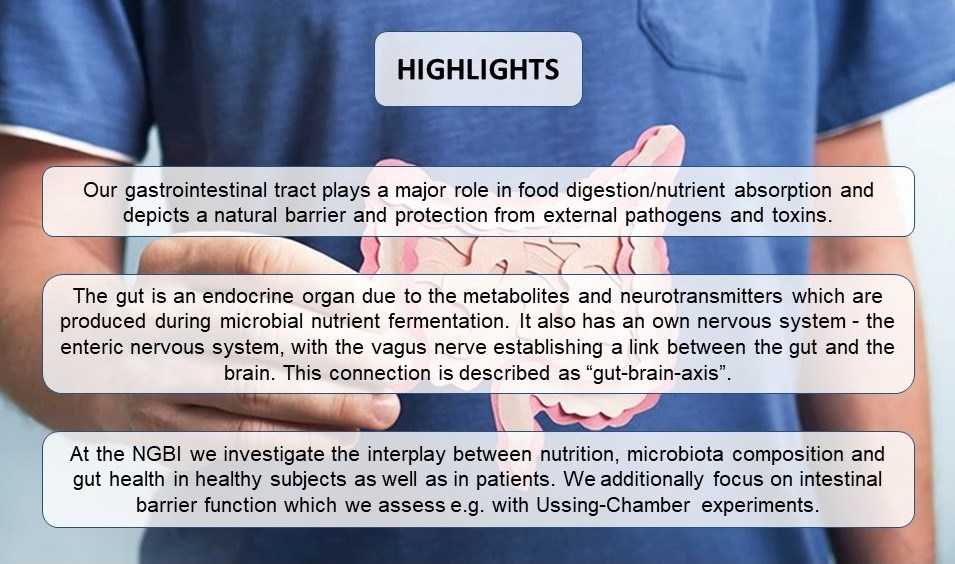Gut
Our gastrointestinal tract plays a major role in food digestion and nutrient absorption. A variety of digestive enzymes are secreted throughout our digestive system to break down nutrients in order to facilitate their uptake through the small intestine. Most nutrients that reach the colon are subsequently fermented by the gut microbiota.

Since these fermentation products constitute microbial metabolites and neurotransmitters, the gut is also referred to as endocrine organ (1) – not least, because enteroendocrine cells which line the gastrointestinal tract secrete hormones that can affect a variety of different processes throughout our body (2). However, our gut is also a sensory organ as it is innervated by neurons that belong to the enteric nervous system, with the vagus nerve establishing a link between the gastrointestinal system and the central nervous system (3). The established connection between gut and brain via metabolites and nervous system is described as “gut-brain-axis” and in the literature our gut is often linked to the term “second brain” (4).
Additionally, the gut depicts a natural barrier between the outer and inner world which consists of mainly three different components – the mucosal barrier, the semipermeable intestinal epithelium, and the mucosal immune system – which all taken together protect us from external pathogenic microbes and toxins (5).
At the NGBI we investigate the interplay between nutrition, microbiota composition and gut health in healthy subjects as well as those suffering from an acute or chronic health disorder. An important research area, amongst others, is intestinal permeability since an increase may lead to local and/or systemic inflammation due to translocation of pathogens from the gut lumen into the circulation which has been shown to be associated with a variety of different diseases such as IBD (6).
A frequently applied method to assess intestinal permeability in our in vivo studies is the so-called multi-sugar test (7). This method was for example used in one of our studies assessing sauna dehydration as novel model for intestinal barrier function (8). Furthermore, we are one of the limited number of research centers in the world routinely using Ussing chambers to measure permeability of colonic biopsies (very small tissue specimen obtained during an endoscopic investigation) ex vivo to assess, for instance, the effects of butyrate (9) or dietary fibre (10) on intestinal barrier function.
- A. Burokas, R.D. Moloney, T.G. Dinan, J.F. Cryan; Chapter one-microbiota regulation of the mammalian gut–brain axis; Adv Appl Microbiol, 91 (2015), pp. 1-62.
- Rehfeld J. F. (1998). The new biology of gastrointestinal hormones. Physiological reviews, 78(4), 1087–1108. https://doi.org/10.1152/physrev.1998.78.4.1087
- Furness, J. B., Callaghan, B. P., Rivera, L. R., & Cho, H. J. (2014). The enteric nervous system and gastrointestinal innervation: integrated local and central control. Advances in experimental medicine and biology, 817, 39–71. https://doi.org/10.1007/978-1-4939-0897-4_3
- Cryan, J. F., O'Riordan, K. J., Cowan, C., Sandhu, K. V., Bastiaanssen, T., Boehme, M., Codagnone, M. G., Cussotto, S., Fulling, C., Golubeva, A. V., Guzzetta, K. E., Jaggar, M., Long-Smith, C. M., Lyte, J. M., Martin, J. A., Molinero-Perez, A., Moloney, G., Morelli, E., Morillas, E., O'Connor, R., … Dinan, T. G. (2019). The Microbiota-Gut-Brain Axis. Physiological reviews, 99(4), 1877–2013. https://doi.org/10.1152/physrev.00018.2018
- Camilleri, M., Lyle, B. J., Madsen, K. L., Sonnenburg, J., Verbeke, K., & Wu, G. D. (2019). Role for diet in normal gut barrier function: developing guidance within the framework of food-labeling regulations. American journal of physiology. Gastrointestinal and liver physiology, 317(1), G17–G39. https://doi.org/10.1152/ajpgi.00063.2019
- Koenig J, Brummer RJ. Alteration of the intestinal microbiota as a cause of and a potential therapeutic option in irritable bowel syndrome. Benef Microbes 2014; 5: 247–261
- van Wijck K, Verlinden TJM, van Eijk HMH et al. Novel multi-sugar assay for site-specific gastrointestinal permeability analysis: a randomized controlled crossover trial. Clin Nutr 2013; 32: 245–251
- Roca Rubio, M. F., Eriksson, U., Brummer, R. J., & König, J. (2021). Sauna dehydration as a new physiological challenge model for intestinal barrier function. Scientific reports, 11(1), 15514. https://doi.org/10.1038/s41598-021-94814-0
- Tabat, M. W., Marques, T. M., Markgren, M., Löfvendahl, L., Brummer, R. J., & Wall, R. (2020). Acute Effects of Butyrate on Induced Hyperpermeability and Tight Junction Protein Expression in Human Colonic Tissues. Biomolecules, 10(5), 766. https://doi.org/10.3390/biom10050766
- Ganda Mall, J. P., Löfvendahl, L., Lindqvist, C. M., Brummer, R. J., Keita, Å. V., & Schoultz, I. (2018). Differential effects of dietary fibres on colonic barrier function in elderly individuals with gastrointestinal symptoms. Scientific reports, 8(1), 13404. https://doi.org/10.1038/s41598-018-31492-5
